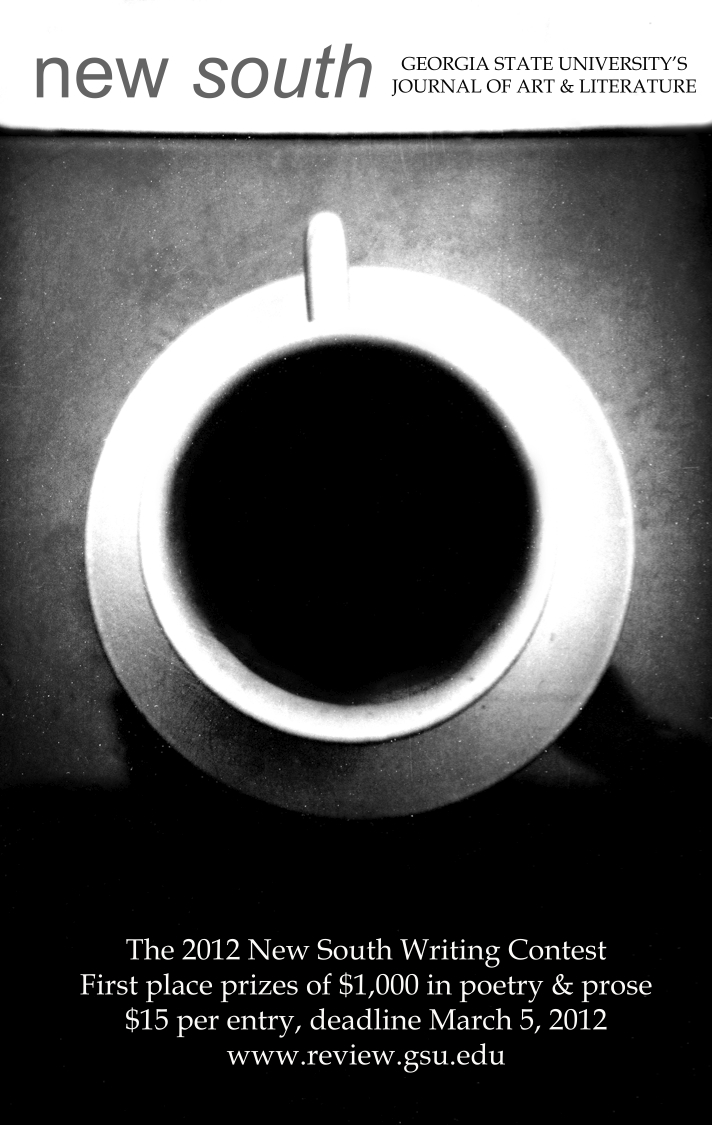Each week we will be featuring one of our many talented interns here at Superstition Review.
prose
Contest: New South
Contest Guidelines:
The 2012 New South Writing Contest will be held from December 1, 2011 through March 5, 2012. (Entries must be received or postmarked by midnight on March 5, 2012.)
Each year, New South awards $1,000 to a first place winner, and $250 to a second place winner in the genres of poetry and prose.
The 2012 New South Writing Contest will be be judged by Tom Hunley in the genre of poetry and Joshua Harmon in the genre of prose.
While we take the greatest care in handling your entries, we assume no responsibility for lost manuscripts. Only unpublished work will be considered. Simultaneous submissions will be considered with notification. All rights revert to author after publication. Current students, staff, and faculty at Georgia State University are not eligible.
New South publishes quality literary art promoting the work of emerging and established writers. New South holds no subject biases. The staff will select the best work regardless of style or genre. The final round of judging will be anonymous (the names will be removed from the manuscripts before the final judges see the entries). Judges from outside the staff will pick the winners from finalists selected by the New South staff.
Please send up to three poems, one short story, or one essay per entry fee. (Prose pieces should not exceed 9,000 words.) Whether it is submitted online or via the mail, each entry must include:
1) A reading fee of fifteen dollars ($15). Entry fee includes a copy of the Summer 2012 issue, which will contain the winning entries.
2) The submitter’s contact info, including telephone number, email, and mailing address, preferably contained within a formal cover letter.
TO ENTER:
*Visit Tell it Slant (http://www.tellitslant.com) for online submissions. Payment accepted via PayPal.
OR
* Send your manuscript, along with a check or money order for $15 made payable to Georgia State University, to:
New South
Campus Box 1894
Georgia State University
MSC 8R0322 Unit 8
Atlanta, Georgia 30303-3083
Forthcoming: Meg Pokrass
 How short can a short story be? Meg Pokrass asks – and answers – that question in her fiction, which often takes the form of flash-fiction and micro-stories. Though her stories are short, they pack the same emotional punch that can be found in a lengthy piece of a prose. She delivers her characters and narrative in compact, meticulously chosen details. For example, in her short-short story “The Big Dipper,” about a young girl trying to navigate her adolescence by purchasing a four-foot-deep pool for her backyard, she conveys a great deal of personal information about her main character’s background in a single sentence. Referring to her mother, the narrator divulges that “Now that Dad has his own place and his bi-polar disorder, she had all kinds of new expressions.” Some of her shortest stories are only between 90 and 100 words long. In this compact form she writes of mother-daughter relationships, adolescence, sexuality, insecurity, and identity.
How short can a short story be? Meg Pokrass asks – and answers – that question in her fiction, which often takes the form of flash-fiction and micro-stories. Though her stories are short, they pack the same emotional punch that can be found in a lengthy piece of a prose. She delivers her characters and narrative in compact, meticulously chosen details. For example, in her short-short story “The Big Dipper,” about a young girl trying to navigate her adolescence by purchasing a four-foot-deep pool for her backyard, she conveys a great deal of personal information about her main character’s background in a single sentence. Referring to her mother, the narrator divulges that “Now that Dad has his own place and his bi-polar disorder, she had all kinds of new expressions.” Some of her shortest stories are only between 90 and 100 words long. In this compact form she writes of mother-daughter relationships, adolescence, sexuality, insecurity, and identity.
In her review of Meg Pokrass’s recent collection of short stories, Damn Sure Right, Tessa Mellas compares Pokrass’s flash fiction to the “richest morsels of chocolate. You can’t inhale them by the fistful.” This description does Pokrass’s stories justice; her fiction demands that you stop for a moment after reading, that you take in every single detail individually to get the full experience of her micro-narratives.
We asked Meg Pokrass to share her writing process, in particular what inspired the short story that will be appearing in Superstition Review Issue 8, which will launch in December. Click here to view the video that gives us a glance behind the scenes.
Visit her website at http://www.megpokrass.com
Announcing: Kat Meads
 In 2008, in Issue 2, Superstition Review published Kat Meads’ essay “Relativism: The Size of the Tsar in Vegas.” We were honored for her contribution, and we are now very happy to share the news of her recently released novel.
In 2008, in Issue 2, Superstition Review published Kat Meads’ essay “Relativism: The Size of the Tsar in Vegas.” We were honored for her contribution, and we are now very happy to share the news of her recently released novel.
Announcing:
when the dust finally settles
by Kat Meads
A novel about land, loyalty and racial politics in the 1968 South
Ravenna Press, September 2011
http://www.katmeads.com
Advance Praise for when the dust finally settles:
When anyone asks if Southern Literature has a future in our internet, iPhone, jet-lagged, speed-of-light world, I point them to Kat Meads. Her fiction is Southern through and through even as it embraces the dilemmas and contradictions of 21st century life. Simply put, you must read Kat Meads.
—Jason Sanford, Founding Editor, storySouth
Kat Meads’ writing is keen and precise; her stories, populous and lively. In when the dust finally settles, she employs a staccato, rhythmic prose in the service of a narrative both beautifully imagined and wildly exotic. when the dust finally settles will keep you up nights reading its propulsive story, but will also reward the reader who loves finely crafted sentences and pitch-perfect dialogue.
—Corey Mesler, author of Following Richard Brautigan
In The Invented Life of Kitty Duncan, Kat Meads created a 1950’s-era Scarlett O’Hara in eastern North Carolina. Now, in when the dust finally settles, she speaks through Faulknerian voices as white and black members of her small eastern North Carolina community desegregate the schools in the 1960’s. Meads’ Clarence Carter, speaking from the dead, provides a surprisingly upbeat (and humorous) perspective on the events unfolding in the community he has not yet quite left. The other voices, young and old, share Clarence’s openness to change—a refreshingly different Southern story.
—Dr. Margaret D. Bauer, Rives Chair of Southern Literature, East Carolina University;
Editor, North Carolina Literary Review
_______________________
The Reading Period at Superstition Review has opened. Please send us your submissions of art, poetry, fiction, and nonfiction between now and October 31st.
The Steps to the Story
I cannot count how many times I have been asked what my writing process is. It must be a writer’s most frequently asked question right up there with “Where do you get your inspiration from?” and “How do you spell (insert any word here)?” Because of this, I decided it would be worthwhile to compile a list of steps based on my own writing process and a few friends’ processes.
Please realize, these steps have been made with a longer, prose style type writing in mind but can also be applied to poetry, plays, academic writing, or anything else involving words.
Step One: Idea
To start writing, you must first have an idea of what to write about. Obviously. The unobvious part is where you obtain the idea. Inspiration can come from anything from a dream, to a lived experience, to a passing billboard. Sometimes ideas drift slowly, seeping into your brain in small waves of images and words. Other times, ideas creep up, grab you firmly, and yell “Write me now!” Regardless of how the idea presents itself, it’s a good idea to write it down.
Step One Point Five: Plan
This step can sometimes be skipped, and other times be labored over more than the actual writing. It really all depends on the author and the complexity of the story. Starting a plan can sometimes be as difficult or even more so than writing the story. It’s usually good to start with an outline of major events and a page of character bios. From there, fill in as many details as you deem necessary until you are comfortable enough to start writing.
Step Two: Write
The best and the worst part of the steps. On the one hand, your idea is realized! On the other hand, it will take countless hair pulling, pencil sharpening, teeth grinding, sweating, coffee consuming hours to make that idea real. Ok, so writing isn’t always that bad. A lot of the time, writing is fun! Either way, I find it best to sit down and write out the idea all the way through. Obviously, not every idea can be hammered out in one session at the computer but it is still best to write the story from beginning to end. Some writers like to go back and edit as they add more. I caution against that for the simple reason of many times you will get stuck trying to perfect the beginning and lose interest in finishing the story. If you have a hard time making yourself write all the way through, considering signing up for NaNoWriMo. National Novel Writing Month takes place in November with the goal to complete a 50,000-word novel between 12:00 am November 1st and 11:59 pm November 30th.
Step Three: Read
You’ve sat down and slammed out 20,000 words of brilliance. Now is a good time to go back, read it, and add more if you wish.
Step Four: Edit
Some writers hate this step. More loathe it. Personally, this is my favorite step and I believe it is the most important. Anyone can write, but it takes a true artist to do it well. This is where editing comes in. Take a fine-toothed comb to your work. Start with spelling and grammar and work your way to tone. A professor once told me if a single word has no function in your writing then throw it out. Be your biggest critic and edit away!
Step Five: Use Your Friends
That’s what they’re there for! Use away! Hand them a copy and make them read and review it honestly. If your friends are only praising your work, you may be that great. Or you may want to consider giving your story to a mentor or joining a writing group.
Step Six: Repeat
Repeat Steps Three, Four and Five as many times and in whatever order you want until you are happy with your work. It may not ever be perfect, but it can be finished. When you’re comfortable, stick a fork in it and send it out to be published or frame it and hang it on the wall. Whichever you prefer.
Remember, these steps don’t work for everyone. But if you’re faced with a monster of an idea and aren’t sure of how to approach it, you can always try following them.
Moving Right Along…
With our solicitations sent out and the submitted works starting to filter in, the Prose and Poetry Teams been busy looking things over in that realm, but have had to shift their focus to the upcoming series of interviews in their future. Our prose and poetry editors were busy this week researching the writers they intend to interview this semester, gathering facts and preparing questions to submit to the authors. And, as was announced at the SR reading on Monday evening, we’ve already got an exciting author lined up–award-winning fiction writer, Ron Carlson!
The Art editors have already had their hands full looking through the submissions drifting in. They’re be working on responding to their solicitations and have been queuing up potential contributors for this upcoming issue of SR.
The Administrative Team had their work cut out for them: besides coordinating the reading at Changing Hands, they also made progress on the Kindle project and worked on the parameters for the first-ever SR writing contest.
Our Content interns are starting to piece together the actual work that’s being considered for publication in the journal. They’re been busy logging all work that’s been drifting in so as to keep things from slipping through the cracks; because SR is digital, and all exchanges are through electronic means, it becomes critical that we have a way to track all of these and make sure all the work we receive has a record to track; this team keeps the magazine running smoothly.
The Web Design Team has simply continued working behind the scenes on the redesign of the website. We released some potential design ideas this week and are receiving feedback from all the interns before we proceed, but the site is progressing nicely. As part of my duty as Blogger I attended the reading and live-tweeted, so in case you missed it you can catch up with what the reading was like here, at least until the reading review is posted. And, as always, I’ll be here, filling you in, so you can stay up-to-the-minute with the editing process here at SR.
This Past Week: Call for Contributors Begins
This week has been a little crazy for the interns at Superstition Review–the semester’s just taking off and things have been getting busy!
The prose and poetry editors have completed their solicitation lists this week and are preparing to email writers we’re all hoping will contribute to the fourth issue of SR. They’ve also been working on a list of writers they’d like to interview for the journal. This is an exciting time for these editors because right now they’re working with infinite possibilities on who to ask for contributions, and who to interview–it’s not until next week, when they send out emails to their lists of people, that the anxiety sets in while they wait for replies.
The art editors are working along those same lines. They’re reviewing artists’ works, looking at suggestions and their lists of solicitations, and trying to figure out whom they would like to approach for a contribution.
These editing teams, the prose, poetry, and art, have also alerted the Content Team of their full lists of solicitations and interview-hopefuls in order to let these interns keep tabs on what’s going in and out at the journal. The Content Team must keep track of what will be featured and what’s making the editing cut, so it’s equally important they get the foundational work done now.
The Web Design team is continuing to discuss how to improve the site for increased ease of navigation and aesthetic appeal. The interns in this group are working on getting photos of all the interns up, new site design, and, of course, keeping you up to date on what’s going on via the blog, our Twitter account, and our Facebook fan page.
Our administrative interns are busy with all things media this week: they’ve been planning the upcoming Reading Series, coming up with a contest for the journal, researching advertising opportunities, and, perhaps the most exciting for our readers, working on a Kindle-based version of SR.
Trish, our Editor-in-Chief has been attending meetings with the individual teams, keeping us updated with podcasts, and making sure things run smoothly, all while handling her normal full teaching load at ASU Polytechnic this semester.
That about wraps it up for this week. Next week, with solicitations leaving the desks of the interns, it’ll be a high-anxiety, nervous, and, frankly, exhilarating time as we keep our fingers crossed to see who decides they’d like to submit to SR.
Spotlight on Rebekah Richgels, by Danielle Kuffler
 Danielle Kuffler: What is your process when reviewing a submission?
Danielle Kuffler: What is your process when reviewing a submission?
Rebekah Richgels: I generally skip the title and dive straight into the story. If it is poorly punctuated or confusing, sometimes I have to start over. Once I am about a third of the way through, if I’m not invested in the story yet I call it a No. As I read, I look for character development and depth, interesting subject matter that draws me in and keeps me reading, and a coherent plot. Ideally these things also come with good prose. If a story has all that I say Yes. I love that we do a blind read of the stories so we aren’t swayed by the author’s fame or lack thereof.
DK: What has been your best SR moment?
RR: My best moment with SR was definitely when Sara Scoville and I interviewed TC Boyle. I was really nervous ahead of time, but he made everything really relaxed and the whole experience turned out amazingly.
DK: What has been your worst SR moment?
RR: It’s not that bad, but my worst SR moment was at the beginning of Fall 2008, when I accidentally solicited from a poet and he emailed back telling me he didn’t do fiction. I tried to respond in a joking way and also pass the blame, which made us all look pretty unprofessional. I learned from it, though, and I’m a lot more thorough with my solicitations now.
DK: What is your favorite book or author/poet?
RR: My favorite author is John Steinbeck, but I also love reading pieces by Rick Reilly, former writer for Sports Illustrated.
DK: What was the first book you ever read?
RR: I’m not sure about the first book I ever read, but the first ones I remember reading were the Boxcar Children series. I read so many of them that I even had a dream where I was reading one.
DK: What skills of yours are most beneficial to SR?
RR: I like to think that I work pretty hard to get through the things we need to do. I can sit down and run through a lot of work in a day if that’s what we need to catch up. I think I do a good job, too, of explaining situations to other people, like Sarah Dillard, my other fiction editor, so that she felt up to speed with our jobs here.
DK: What are you reading currently?
RR: I just finished Leaving Atlanta, Tayari Jones’ first book, and am starting Which Brings Me To You, the collaborative novel between Julianna Baggott and Steve Almond. I am also reading Bright Lights, Big City, by Jay McInerney for my Literary Forms class.
DK: What is your favorite work of nonfiction?
RR: I guess I would have to say Ghost Soldiers, the book about the Bataan Death March, because it was the first nonfiction book I had ever chosen to read. I really prefer the fiction world.
DK: What is your favorite work of art or artist?
RR: I love Rodin. For some reason, his sculptures seem especially beautiful to me.
DK: What are some advantages to working in the online format of SR?
RR: The best advantage of working online is the space. We have no limit to how much we publish, and aren’t limited by printing costs either.
DK: What kind of experiences have you gained at SR that will help in your future?
RR: I have learned better responsibility and independence, as well as increased diplomacy and really great connections to the literary world.

